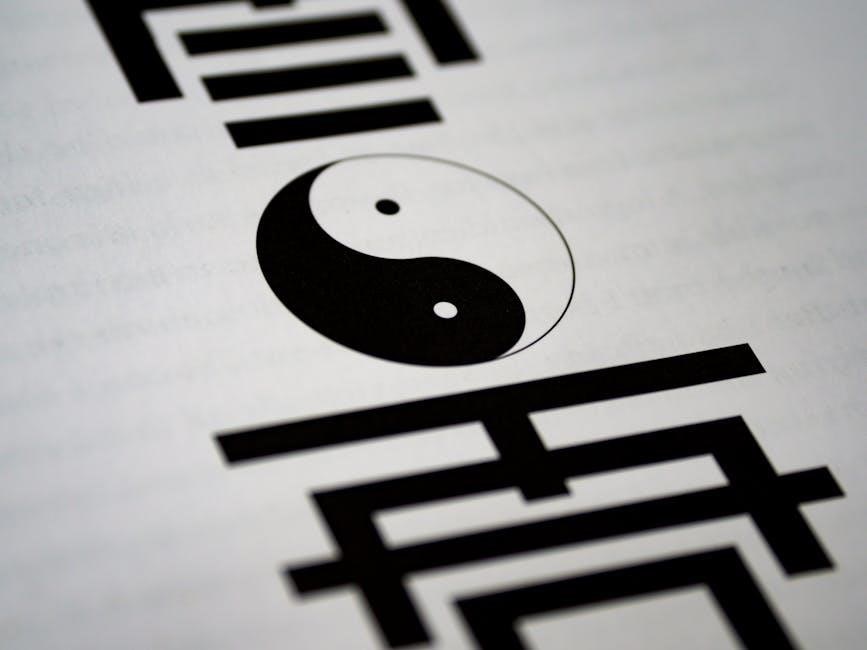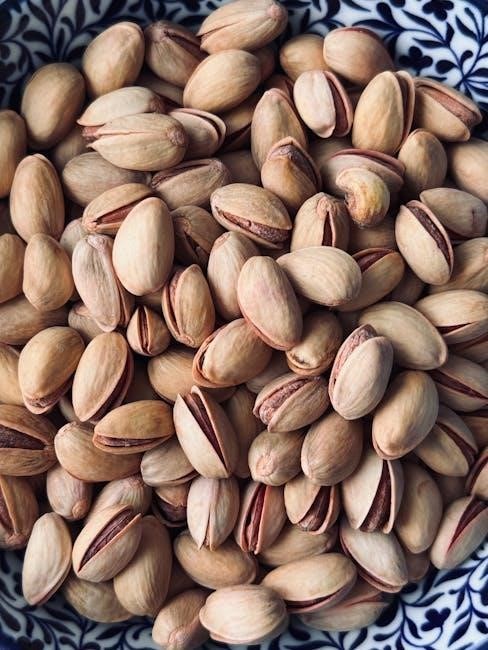The Yin Yang Food Chart is a traditional Chinese medicine guide categorizing foods by their energetic properties. It helps balance body energies, promoting harmony and well-being through dietary choices.
Understanding Yin and Yang in Traditional Chinese Medicine (TCM)
In Traditional Chinese Medicine, Yin and Yang represent the harmonious duality of opposites that govern the natural world. Yin embodies coolness, passivity, and receptivity, while Yang symbolizes warmth, activity, and creativity; These principles are interconnected and interdependent, forming the foundation of TCM diagnostics and treatments. Yin and Yang are used to describe physiological states, such as excess or deficiency, and guide therapeutic interventions. For instance, Yin energies are associated with cooling, calming, and nourishing the body, while Yang energies focus on warming, energizing, and stimulating. The balance of Yin and Yang is crucial for maintaining health, as their disharmony can lead to illness. This concept extends to food, where foods are classified based on their energetic properties to restore equilibrium to the body. Understanding Yin and Yang is essential for applying the food chart effectively in promoting well-being.
The Concept of Energetic Properties of Foods
The energetic properties of foods, as outlined in the Yin Yang Food Chart, classify them based on their temperature and effect on the body. Foods are categorized as Hot, Warm, Cool, Cold, or Neutral, influencing Qi and blood flow. Hot and Warm foods are Yang, enhancing energy and warmth, while Cool and Cold foods are Yin, promoting relaxation and cooling. Neutral foods balance both. These properties help restore equilibrium, addressing conditions like excessive heat or cold in the body. By choosing foods that counteract imbalances, individuals can harmonize their Yin and Yang, supporting overall health and vitality. This approach emphasizes food as medicine, guiding tailored dietary choices for optimal well-being. The chart provides a clear framework to understand and apply these principles effectively in daily nutrition.
Classification of Foods in Yin Yang Theory
Foods are classified as Hot, Warm, Cool, Cold, or Neutral, aligning with Yin and Yang principles to restore balance and harmony in the body’s energy.
Hot, Warm, Cool, Cold, and Neutral Foods
In Yin Yang theory, foods are categorized based on their thermal properties: Hot, Warm, Cool, Cold, and Neutral. Hot and Warm foods are considered Yang, boosting energy and warmth, while Cool and Cold foods are Yin, calming and reducing heat. Neutral foods balance both energies. Examples of Hot foods include chili peppers and garlic, which stimulate Qi and warmth. Warm foods, like ginger and lamb, gently nourish Yang without overstimulating. Cool foods, such as cucumbers and mint, help reduce excess heat, while Cold foods, like raw fish and ice cream, cool the body deeply. Neutral foods, such as rice and sweet potatoes, harmonize Yin and Yang, making them ideal for balancing diets. This classification helps guide food choices to restore energy equilibrium and promote health according to TCM principles.
Yin Foods: Cooling and Calming Properties

Yin foods are characterized by their cooling and calming properties, helping to reduce excess heat and restore balance in the body. These foods are often associated with replenishing fluids, soothing inflammation, and calming the mind. Examples of Yin foods include cucumbers, watermelon, and tofu, which are known for their cooling effects. They are particularly beneficial for individuals with Yang excess, such as those experiencing symptoms like red eyes, dry mouth, or constipation. Yin foods work to counteract heat by nourishing the body’s cooling energies and promoting harmony. By incorporating these foods into the diet, one can effectively manage heat-related imbalances and maintain a balanced state of health according to TCM principles.
Yang Foods: Warming and Energizing Properties
Yang foods are known for their warming and energizing properties, helping to counteract cold and weakness in the body. These foods are ideal for individuals with a deficiency of Yang energy, characterized by symptoms such as cold hands, fatigue, and poor circulation. Examples of Yang foods include ginger, garlic, and lamb, which are renowned for their ability to stimulate internal warmth and boost vitality. By consuming Yang foods, one can enhance digestion, improve energy levels, and support overall health. They are particularly beneficial during colder seasons or for those with a naturally cooler constitution. Incorporating these foods into the diet helps restore balance and vitality, aligning with TCM principles of nourishing and harmonizing the body’s energies.

Practical Application of the Yin Yang Food Chart
The chart helps balance Yin and Yang energies by guiding food choices, ensuring seasonal adaptation, and promoting overall well-being through harmonized dietary practices rooted in TCM principles.
How to Use the Chart for Balanced Nutrition
Using the Yin Yang Food Chart involves identifying your personal energy type and selecting foods that balance your Yin and Yang energies. Start by assessing whether you lean toward heat or cold, excess or deficiency. Choose foods that counteract imbalances—cooling Yin foods for excess heat and warming Yang foods for cold deficiency. Consider seasonal variations, as certain foods align with specific times of the year. Incorporate neutral foods like rice and sweet potatoes to harmonize Qi and Blood. Avoid extreme temperatures and flavors that exacerbate your condition. By aligning your diet with the chart’s guidelines, you can restore equilibrium, enhance vitality, and support overall health. Regular adjustments ensure sustained balance and well-being.
Examples of Yin and Yang Foods
Yin foods are typically cooling and include items like watermelon, cucumber, and mint, which help reduce body heat. Yang foods, such as ginger, chili, and lamb, are warming and energizing. Neutral options like rice, corn, and sweet potatoes balance both energies. These examples guide dietary choices to restore harmony and support health. By selecting foods that align with your energy needs, you can enhance well-being and vitality. These examples provide a clear starting point for applying Yin Yang principles to everyday meals. Proper food selection ensures a balanced and nourishing diet tailored to individual requirements.

Dietary Guidelines Based on Yin Yang Principles

Balance Yin and Yang by consuming foods that align with your body’s energy. Avoid extreme temperatures and incorporate neutral foods to harmonize Qi and maintain vitality.
Nourishing Yin: Cooling Foods for Balance
Nourishing Yin involves consuming cooling foods to balance the body’s energy. These foods help reduce heat, calm the mind, and replenish fluids. Examples include cucumbers, watermelon, and green vegetables, which are ideal for individuals with excess Yang energy. Cooling foods counteract symptoms like thirst, dry mouth, and red eyes. They also support the body’s natural healing processes and promote relaxation. Incorporating these foods into your diet helps maintain harmony between Yin and Yang, ensuring optimal health. Neutral foods like rice and corn can complement cooling foods to enhance their benefits. By focusing on seasonal and energetically appropriate foods, you can achieve a balanced and nourishing diet;
Warming Yang: Energizing Foods for Health
Warming Yang foods are essential for energizing the body and counteracting coldness. These foods, such as ginger, garlic, and chili peppers, are classified as “hot” or “warm” in traditional Chinese medicine. They help stimulate circulation, boost energy, and strengthen the body’s Yang energy. Ideal for individuals with cold hands, fatigue, or a slow metabolism, Yang foods promote vitality and warmth. They are particularly beneficial during colder seasons or for those with a predominantly Yin constitution. Incorporating these foods into your diet can help balance your energy, improve digestion, and enhance overall well-being. By nourishing Yang, you support the body’s active and transformative processes, ensuring harmony between Yin and Yang energies.

Neutral Foods and Their Role in Balancing Yin and Yang
Neutral foods like rice, corn, and sweet potatoes balance Yin and Yang by harmonizing Qi and blood. They stabilize the body without causing excess or deficiency.
Foods That Harmonize Qi and Blood
Certain neutral foods, such as sweet potatoes and turnips, are known to harmonize Qi and blood, ensuring a balanced energy flow and overall health. These foods are neither too warming nor too cooling, making them ideal for maintaining equilibrium. They support the body’s natural processes without causing excess or deficiency. By incorporating these foods into a diet, individuals can promote stability and well-being, aligning with the principles of Yin and Yang. These foods are versatile and can be prepared in various ways, making them a practical choice for everyday meals; Their role in balancing energy highlights their importance in traditional Chinese medicine.
The Yin Yang Food Chart offers a holistic approach to nutrition, balancing energies for optimal health and well-being, making it a valuable guide for modern dietary practices.
The Importance of Yin Yang Food Chart in Modern Diet

The Yin Yang Food Chart serves as a vital tool in modern nutrition, offering a holistic approach to dietary balance. By categorizing foods into yin and yang, it helps individuals harmonize their energies, addressing contemporary health concerns like energy imbalances and chronic diseases. This chart bridges ancient wisdom with modern dietary needs, providing personalized nutrition guidance. It emphasizes the role of neutral foods in balancing Qi and Blood, making it adaptable to diverse lifestyles. As people seek natural ways to enhance well-being, the Yin Yang Food Chart becomes increasingly relevant, promoting long-term health and vitality through mindful food choices.